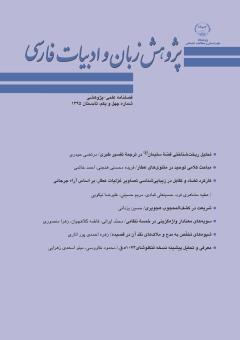معرفی و تحلیل پیشینه نسخه تَنکلوشای1074ه.ق.
محورهای موضوعی : پژوهشهای ادبیات کلاسیک ایرانمحمود طاووسی 1 * , مینو اسعدی زهرایی 2
1 - استاد گروه پژوهش هنر، دانشگاه تربیت مدرس
2 - دکتری گروه پژوهش هنر، دانشگاه تربیت مدرس
کلید واژه: تنکلوشای ادبیات تنجیمی کیش صابی خاقانی نظامی گنجوی,
چکیده مقاله :
چنانکه از منابع کهن دریافت می شود، تنکلوشا از جمله قدیمی ترین آثار مربوط به تنجیم است که بر اساس نجوم ایرانی و با عنایت به حکایات زمان اولیه تألیف خود یعنی دوره ساسانی سامان یافته است. ادبیات تنجیمی چنین حکایت میکند که تنکلوشا پس از سامان در ایران به فارسی میانه، به زبان سریانی، و سپس در دوره اسلامی به عربی ترجمه شده است. این اثر منبع اطلاع بسیاری از ادبیات تنجیمی بعد از خود بوده است، اما از ترجمه سریانی آن اثری نیست، ولی از ترجمههای عربی و نیز ترجمه فارسی آن نسخههایی در دست است و تنکلوشای 1074ه.ق. نمونه ای از ترجمه فارسی آن نسخه است. نسخه تنکلوشای 1074ه.ق. به فرمان پادشاه وقت و به قلم نستعلیق «محمد تقی بن حاجی محمد مشهدی» بازنویسی شده است. موضوع نسخه شرح و پیشگویی طالع در سیصد و شصت درجه بروج است. ویژگی منحصر به فرد نسخه که آن را از سایر نسخههای پیش و پس از آن متمایز مینماید، نگارههای آن است. در حقیقت نگارهها تفسیری بصری از متنهای پیشگویی هستند. جز در دیگر نسخهها جز در شیوه خوشنویسی و تاریخ کتابت تفاوت چندانی با هم ندارند. مقاله دو هدف را دنبال مینماید: ابتدا به این پرسش پاسخ میدهد که آیا تنکلوشای 1074ه.ق. یگانه نسخه نگاره دار بوده است یا خیر. توصیف تنکلوشای مصوّر در اشعار دو شاعر سده ششم هجری یعنی خاقانی و نظامی، سابقه تنکلوشای مصوّر سده یازدهم هجری را تا سده ششم هجری به عقب برمی-گرداند و یگانه بودن آن را رد میکند. از سوی دیگر در منابع تاریخی سابقه تنکلوشا را از پیش از اسلام دانستهاند. هدف اصلی مقاله آگاهی از پیشینه کتاب و پاسخ به این پرسش است که تنکلوشا بیانگر باورهای کدام قوم است. استناد به منابع کهن بیرونی و تمرکز در برخی عناصر موجود در متن تنکلوشای1074ه.ق. و تجلّی آن در نگارهها نهایتاً ما را به باورهای کیش صابی میرساند.
According to the ancient sources, Tankalucha manuscript is one of the oldest works related to astronomy which has been written in Sassanid era based on Iranian astronomy and stories of the time it was written. According to astronomical literature, after being written in middle Persian (Pahlavi), Tankalucha has been translated into Syriac and later into Arabic in Islamic era. This work has been an information resource for the large number of other works related to astrological literature. Although, there is no evidence of its Syriac translation, there are some manuscripts of its Arabic and Farsi translations, and Tankalucha 1074 H.A. is one of its Farsi translations. Tankalucha 1074 A.H. was rewritten by “Mohammad Taghi-ibn-e-Haji Mohammad Mashadi” in Nastaliq by the command of the king. Subject of the manuscript is foretelling and explanation of the fortune in 360 degrees in ecliptic circle. The unique characteristic of the manuscript which makes it different from the former and latter manuscripts is its motifs. In fact the motifs are visual interpretations of the foretelling texts. No significant difference is observed in any of the other manuscripts except for “the style of calligraphy” and “the date of writing”. This article has two goals. First, it answers the question that whether Tankalucha 1074 A.H. was the only manuscript containing motifs. According to the description of the illustrated Tankalucha in the poems of the two poets of the 6th (hijri) (Khaqani and Nizami) illustrated Tankalucha (11th century) goes back to 6th century, and this rejects its uniqueness. On the other hand, in historical resources, Tankalucha goes back to pre-Islam era. The main goal of this article is learning about the history of the book, and finding the answer to the question that Tankalucha expresses the beliefs of which group of people. According to some external old resources and focusing on some of the elements in Tankalucha 1074 A.H. text, and its representation in motifs lead us to Citation to the beliefs of Sabian religion.
قرآن کریم ابن قفطی (1371) تاریخ الحکماء، ترجمه بهین دارایی، تهران، مؤسسه انتشارات و چاپ دانشگاه تهران.
اصفهانی، حمزه بن حسن (1346) تاریخ پیامبران و شاهان، ترجمه جعفر شعار، تهران، بنیاد فرهنگ ایران.
بیرونی، ابوریحان (1363) آثارالباقیه، ترجمه اکبر دانا سرشت، تهران، مؤسسه امیرکبیر.
تفضلی، احمد (1376) تایخ ادبیات پیش از اسلام، تهران، سخن.
حائری، عبدالحسین (1346) فهرست کتب خطی کتابخانه مجلس شورای ملی، تهران.
دمشقی، شمس¬الدین محمدبن ابی طالب انصاری (1357) نُخبه الدّهر فی عجائب البرّ و البحر، ترجمه حبیب طبیبیان، تهران، فرهنگستان ادب و هنر ایران.
رضازاده ملک، رحیم (1384) تنکلوشا، تهران ، مرکز نشر میراث مکتوب.
رضی، هاشم (1371) گاهشماری و جشنهای ایران باستان، تهران، بهجت.
فضایلی، سودابه (1384) فرهنگ غرایب، جلد1، تهران، افکار.
قاسملو، فرید (1383) «تنگلوشا» در دانشنامه جهان اسلام، جلد هشتم، زیر نظر غلامعلی حداد عادل، تهران، بنیاد دایرةالمعارف اسلامی.
کرامتی، یونس (1387) «تنگلوشا» در دایرةالمعارف بزرگ اسلامی، جلد شانزده، زیر نظر کاظم موسوی، تهران، مرکز دایرةالمعارف بزرگ اسلامی.
کلبی، ابومنذر هشام بن محمد (1364) کتاب الاصنام، ترجمه محمدرضا جلالی نائینی، تهران، نشر نو.
مسعودی، علی بن حسین (1344) مروج الذّهب و معادن الجوهر، ترجمه ابوالقاسم پاینده، ج1، تهران، بنگاه ترجمه و نشر کتاب.
مشکور، محمد جواد (1361) هفتاد و سه ملت، تهران، مؤسسه مطبوعاتی عطائی.
مصفّی، ابوالفضل (1366) فرهنگ اصطلاحات نجومی همراه با واژههای کیهانی در شعر فارسی، تهران، مؤسسه تحقیقات و مطالعات فرهنگی.
نصر، حسین (1366) علم در اسلام، ترجمه احمد آرام، تهران، سروش.
هاشمی عباسی، مصطفی بن خالقداد (1358) توضیح الملل، ترجمه کتاب الملل و النحلِ ابوالفتح محمدبن عبدالکریم شهرستانی، ترجمه محمد رضا جلالی نائینی، جلد2 ، بیجا.
همایونفرخ، رکن¬الدین (1357) تنگ لوشا یا صوَر دَرَج، تهران، دانشگاه ملی ایران.
Peterson, A. (1999) Dictionary of Islamic Architecture, london, Routledge.

